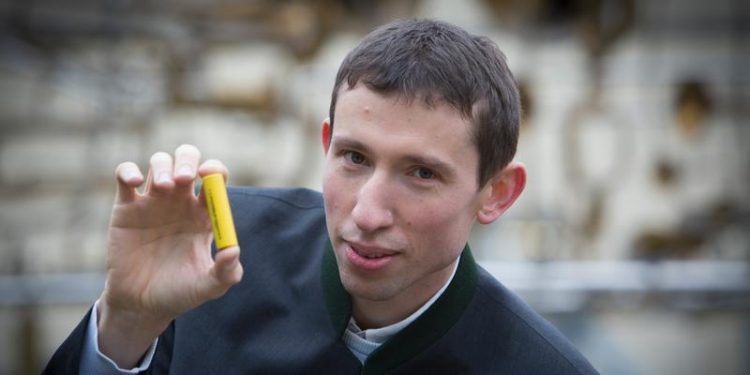Energy hybrid: Battery meets super capacitor

After stations in Zurich, Kanada and Scotland ERC Starting Grant awardee Stefan Freunberger researches on new energy storage systems at TU Graz. © Lunghammer - TU Graz
Batteries and super capacitors are electrochemical energy storage media, but they are as different as night and day. Both are capable of energy storage and targeted energy release – and yet there are major differences between the two.
Batteries store very large amounts of energy that is released slowly but constantly. By contrast, super capacitors can only store small amounts of energy, but they release this energy much faster and more powerfully with large short-term peak currents.
Stefan Freunberger at TU Graz together with a group of researchers from Université de Montpellier in Southern France had a sudden flash of insight. Why not exploit the benefits of batteries and super capacitors simultaneously and combine them in some kind of energy hybrid, they asked themselves.
In the current issue of renowned scientific journal Nature Materials the group introduces its approach, describing a liquid energy storage material for the first time in a European Research Council (ERC) sponsored study. While the energy density of this material is comparable to that of a battery, its power output equals that of a super capacitor.
Ions with an urge to move
“Batteries release energy so slowly and take so long to charge because their energy storage materials are solid. This make it difficult for the ions to move. But as the ions in a super capacitor move in a liquid, they are much more mobile than in a solid body,” explains Stefan Freunberger from the Institute of Chemistry and Technology of Materials at TU Graz.
The novel redox active ionic liquid developed by Freunberger in co-operation with the French colleagues consists of an organic salt that is liquid at a temperature of just below 30 °C – only slightly above room temperature. Similar to a solid storage medium this liquid can store many ions, but allows them to be much more mobile.
About tram doors and electric vehicles
The sudden flash of insight of Freunberger and colleagues culminated in a first approach to create an integrated energy supply system that offers a constant energy supply with high-power output. In some cases we are still faced with an either/or decision. Automatic doors, for example in trams or trains, are typical candidates for super capacitors. Energy is only needed for a very short time but when it is, a high-power output is of the essence. In other cases batteries are clearly the first choice.
“But our principle of an energy hybrid can offer enormous advantages, for example when applied in electric vehicles. So far, electric vehicles often carry a combination of different battery types or battery systems together with super capacitors. If we had a single system that combines the benefits of both energy storage types, we could save considerable space and resources,” remarks Freunberger.
Contact:
Stefan FREUNBERGER
Dipl.-Ing. Dr.sc.ETH
Institute for Chemistry and Technology of Materials
Stremayrgasse 9, 8010 Graz
Phone: +43 316 873 32284
Email: freunberger@tugraz.at
http://www.nature.com/nmat/journal/vaop/ncurrent/full/nmat4808.html Original paper on nature.com (doi:10.1038/nmat4808)
Media Contact
All latest news from the category: Power and Electrical Engineering
This topic covers issues related to energy generation, conversion, transportation and consumption and how the industry is addressing the challenge of energy efficiency in general.
innovations-report provides in-depth and informative reports and articles on subjects ranging from wind energy, fuel cell technology, solar energy, geothermal energy, petroleum, gas, nuclear engineering, alternative energy and energy efficiency to fusion, hydrogen and superconductor technologies.
Newest articles

A universal framework for spatial biology
SpatialData is a freely accessible tool to unify and integrate data from different omics technologies accounting for spatial information, which can provide holistic insights into health and disease. Biological processes…

How complex biological processes arise
A $20 million grant from the U.S. National Science Foundation (NSF) will support the establishment and operation of the National Synthesis Center for Emergence in the Molecular and Cellular Sciences (NCEMS) at…

Airborne single-photon lidar system achieves high-resolution 3D imaging
Compact, low-power system opens doors for photon-efficient drone and satellite-based environmental monitoring and mapping. Researchers have developed a compact and lightweight single-photon airborne lidar system that can acquire high-resolution 3D…





















